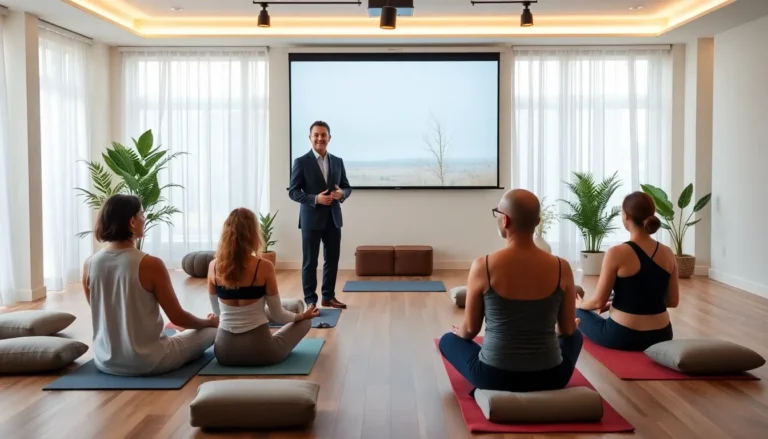Table of Contents
ToggleIn a world buzzing with deadlines and endless to-do lists, stress often feels like an unwelcome houseguest that just won’t leave. But what if there was a way to kick that pesky visitor to the curb? Enter mindfulness practices—your secret weapon against stress that doesn’t involve a magic wand or a time machine.
Imagine sipping your morning coffee while actually tasting it, or taking a stroll without mentally drafting your grocery list. Mindfulness invites you to hit the pause button, breathe deeply, and embrace the present moment. It’s not just about finding zen; it’s about reclaiming your sanity in a chaotic world. So, let’s dive into some fun and effective mindfulness techniques that’ll turn stress relief into a delightful daily ritual.
Overview of Mindfulness Practices
Mindfulness practices focus on cultivating awareness and presence. These techniques enable individuals to engage in the current moment rather than dwell on past concerns or future anxieties. Meditation forms a core aspect of mindfulness, allowing individuals to center their thoughts and breathe deliberately.
Breath awareness also plays a significant role. By concentrating on the rhythm of inhaling and exhaling, people can soothe their minds and reduce stress. Guided imagery offers another approach, where visualizing calming landscapes or scenarios can promote relaxation and mental clarity.
Body scans actively engage individuals with their physical sensations. This practice involves systematically focusing attention on different body parts, aiding in the release of tension. Similarly, mindful walking incorporates movement into mindfulness practices, encouraging participants to notice their surroundings and the sensation of each step.
Journaling serves as a beneficial tool by enabling reflective practice. Writing down thoughts and feelings fosters greater self-awareness and understanding of stress triggers. Additionally, practices such as mindful eating emphasize savoring each bite, transforming daily meals into moments of connection and appreciation.
Participating in gratitude exercises can enhance overall well-being. Recognizing positive experiences reinforces a sense of contentment, even amid stress. Each of these mindfulness practices empowers individuals, equipping them with skills to navigate life’s challenges more effectively.
Integrating these techniques into daily routines can help foster a culture of mindfulness. As individuals commit to these practices, they experience profound shifts in stress management and overall mental health. Awareness becomes a powerful tool for reclaiming peace amidst life’s demands.
Benefits of Mindfulness Practices for Stress Relief
Mindfulness practices offer numerous benefits for stress relief, enhancing overall well-being. These techniques foster present-moment awareness and create a path towards emotional resilience.
Emotional Regulation
Practicing mindfulness significantly enhances emotional regulation. Individuals become more attuned to their feelings, promoting quicker identification of stress reactions. This awareness allows for intentional responses instead of impulsive reactions. Regular engagement in mindfulness exercises cultivates an inner calm, helping manage anxiety and frustration. By developing skills in emotional regulation, people can navigate challenging situations with greater ease. Research shows that consistent mindfulness practice can lead to reduced emotional reactivity, contributing to a stable mental state.
Improved Focus
Improved focus results from regular mindfulness practices. Attention training helps individuals stay present, minimizing distractions from external chaos and internal worries. Techniques such as mindful breathing sharpen concentration and enhance cognitive functioning. Studies indicate that practicing mindfulness can improve one’s ability to sustain attention over extended periods. This enhanced focus leads to greater productivity and efficiency, especially in stressful environments. Engaging in mindfulness reinforces the capacity to prioritize tasks effectively, improving both work performance and personal satisfaction.
Popular Mindfulness Practices
Mindfulness practices offer straightforward methods for stress relief. Techniques vary but focus on cultivating awareness and presence.
Meditation Techniques
Meditation encompasses various approaches, each aiming to enhance focus. Mindful breathing sits at the core of many meditation techniques. Practitioners may choose to sit quietly, allowing thoughts to pass without judgment. Visualization practices also exist; these involve imagining serene scenes to promote relaxation. Regular meditation sessions can significantly improve emotional regulation, creating calm amidst chaos. Many individuals find guided meditations helpful, as they provide direction and support during practice.
Breathing Exercises
Breathing exercises serve as quick tools to reduce stress. Techniques include the 4-7-8 method, where one inhales for four counts, holds for seven, and exhales for eight. Such exercises foster immediate relaxation by engaging the body’s natural response to stress. Another popular method involves diaphragmatic breathing; this encourages deeper breaths and increased oxygen intake. Practitioners often experience lower anxiety levels and improved concentration through consistent use of these techniques. Incorporating these exercises throughout the day ensures ongoing stress management.
Body Scan Practice
Body scan practice offers another effective way to achieve mindfulness. This technique guides individuals through a systematic focus on various body parts, promoting relaxation. Starting from the toes and moving upwards, practitioners often become more attuned to physical sensations. They learn to recognize areas of tension and consciously release that stress. Engaging in regular body scans promotes self-awareness and enhances the mind-body connection. Many use this practice as a prelude to sleep, finding it helps quiet racing thoughts.
Incorporating Mindfulness into Daily Life
Incorporating mindfulness into daily life requires intention and practice. Short daily exercises can significantly improve stress management and enhance overall well-being.
Short Daily Exercises
Engaging in brief mindfulness exercises each day fosters a sense of calm. Practicing mindful breathing for five minutes centers attention on the breath, allowing for stress release. Utilizing the body scan technique for ten minutes encourages individuals to connect with their physical sensations, promoting relaxation. Employing visualization exercises helps create mental imagery that inspires peace and gratitude. Participating in mindful moments, such as pausing to observe surroundings, can also ground individuals in the present.
Mindfulness in Routine Activities
Integrating mindfulness into routine activities transforms mundane tasks into opportunities for awareness. Practicing mindful eating encourages savoring flavors and textures, enhancing the meal experience. When washing dishes, focusing on the sensation of water and the movement of hands nurtures awareness. Commutes provide an excellent chance for mindful listening to music or podcasts, cultivating presence during transitions. Brushing teeth can become a mindful practice by concentrating on each action and sensation, sharpening awareness in daily life.
Embracing mindfulness practices offers a powerful avenue for managing stress in today’s fast-paced environment. By incorporating techniques like meditation and mindful breathing into daily routines, individuals can cultivate a sense of presence that enhances emotional resilience.
These practices not only promote relaxation but also improve focus and productivity, allowing for a more balanced approach to life’s challenges. As one integrates mindfulness into everyday activities, the journey toward greater well-being and peace of mind becomes increasingly attainable.
Making mindfulness a habit can lead to transformative changes, helping to navigate stress with grace and clarity.








